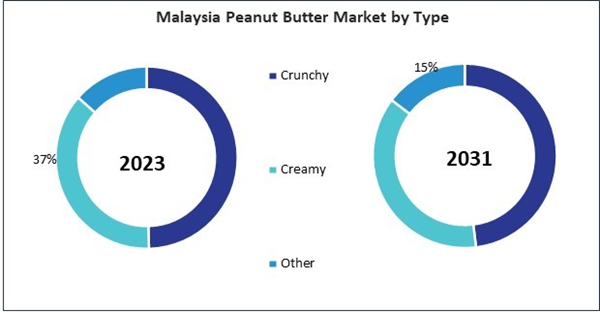Offline distribution channels offer consumers the convenience of immediate access to products, allowing them to browse, compare, and make purchases in-person. Additionally, these channels facilitate tactile experiences, enabling consumers to inspect product quality and packaging before making a purchase decision, which can significantly influence buying behavior. Therefore, the India market utilized 192.50 hundred Tonnes of peanut butter from offline distribution channel in 2023.
The China market dominated the Asia Pacific Peanut Butter Market by Country in 2023 and would continue to be a dominant market till 2031; thereby, achieving a market value of $651.5 Million by 2031. The Japan market is registering a CAGR of 7.8% during (2024 - 2031). Additionally, The India market would showcase a CAGR of 7.1% during (2024 - 2031).
In savory cuisine, peanut butter adds depth and richness to sauces, marinades, and dressings, enhancing the flavor profiles of satay, curries, and stir-fries. Its umami-rich taste pairs well with soy sauce, ginger, garlic, and chili peppers, creating complex and satisfying flavor combinations. In sweet treats, peanut butter takes center stage in various indulgent desserts, including cookies, brownies, cakes, and pies. Its creamy texture and nutty flavor complement a wide range of ingredients, from chocolate and caramel to fruits and spices, resulting in irresistible confections that satisfy the sweet tooth of peanut butter enthusiasts.
Furthermore, beyond traditional applications, peanut butter also finds innovative uses in the culinary, appearing in unconventional dishes such as smoothie bowls, energy bars, salad dressings, and even savory cocktails. Its versatility and adaptability make it a versatile ingredient for chefs and home cooks alike, inspiring creativity and experimentation in the kitchen.
With increasing health consciousness and awareness of the importance of nutrition, there is a growing preference among Indian consumers for healthy and nutritious snack options. Peanut butter, with its high protein content, heart-healthy fats, and essential nutrients, is perceived as a healthier alternative to traditional snack foods. Hence, the growing snack food and food & beverage sectors in Asia Pacific are expected to boost the demand for peanut butter in the region.
Based on Type, the market is segmented into Crunchy, Creamy, and Other. Based on Distribution Channel, the market is segmented into Offline, and Online. Based on countries, the market is segmented into China, Japan, India, South Korea, Australia, Malaysia, and Rest of Asia Pacific.
List of Key Companies Profiled
- The Procter & Gamble Company
- Unilever PLC
- Hormel Foods Corporation (MegaMex Foods, LLC)
- The Kraft Heinz Company
- Associated British Foods PLC (Wittington Investments Limited)
- The Hershey Company
- Mars, Inc.
- Dr. August Oetker KG
- The J.M Smucker Company
- Algood Food Company (Bowman Andros Products, LLC)
Market Report Segmentation
By Type (Volume, Hundred Tonnes, USD Billion, 2020-2031)- Crunchy
- Creamy
- Other
- Offline
- Online
- China
- Japan
- India
- South Korea
- Australia
- Malaysia
- Rest of Asia Pacific
Table of Contents
Companies Mentioned
- The Procter & Gamble Company
- Unilever PLC
- Hormel Foods Corporation (MegaMex Foods, LLC)
- The Kraft Heinz Company
- Associated British Foods PLC (Wittington Investments Limited)
- The Hershey Company
- Mars, Inc.
- Dr. August Oetker KG
- The J.M Smucker Company
- Algood Food Company (Bowman Andros Products, LLC)
Methodology

LOADING...









